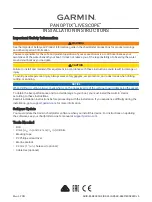
13
If only the back half of the arch is printed, then the nose of the trans-
ducer is angled too far down and needs to be raised.
NOTE:
Periodically wash the transducer's face with soap and water to re-
move any oil film. Oil and dirt on the face will reduce the sensitiv-
ity or may even prevent operation.
Shoot-Thru-Hull Preparation
Hulls With Flotation Materials
The transducer installation inside a fiberglass hull must be in an area
that does not have air bubbles in the resin or separated fiberglass lay-
ers. The sonar signal must pass through solid fiberglass. A successful
transducer installation can be made on hulls with flotation materials
(such as plywood, balsa wood or foam) between layers of fiberglass if
the material is removed from the chosen area. See the figure below.
WARNING:
Do not remove any material from your inner hull unless
you know the hull's composition. Careless grinding or
cutting on your hull can result in damage that could
sink your boat. Contact your boat dealer or manufac-
turer to confirm your hull specifications.
Epoxy the transducer to a solid portion of the hull.
Some (but not all) manufacturers use a layer of fiberglass, then a core
of balsa wood, finishing with an outer layer of fiberglass. Removing the
inner layer of fiberglass and the balsa wood core exposes the outer
layer of fiberglass. The transducer can then be epoxied directly to the
outer layer of fiberglass. After the epoxy cures, the hull is watertight
and structurally sound. Remember, the sonar signal must pass through
solid fiberglass. Any air bubbles in the fiberglass or the epoxy will re-
duce or eliminate the sonar signals.
To choose the proper location for shoot-thru-hull mounting, follow these
testing procedures. You may need a helper to complete these steps.
Fill with resin
Inner hull
Epoxy to hull first
Outer hull
Flotation material
Fill with




































